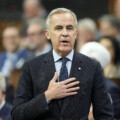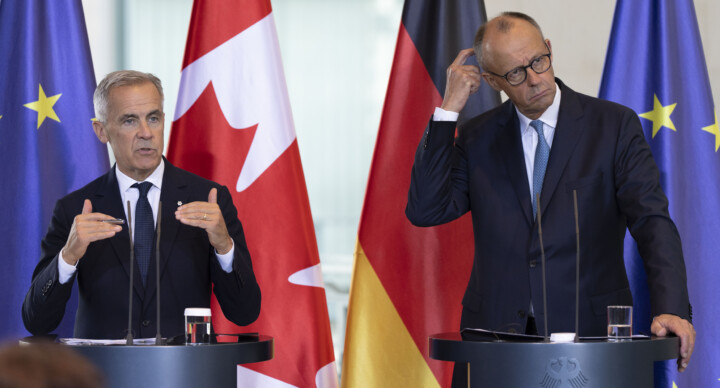Pierre Poilievre is the latest politician to add his voice to the chorus calling for tariffs on imports of Chinese manufactured goods, in particular electric vehicles. To sort through the intricacies and potential consequences of such a proposal, The Hub’s Sean Speer exchanged with Steve Verheul, Canada’s chief trade negotiator from 2017 to 2021 who was responsible for negotiating the Canda-United States-Mexico Agreement (CUSMA) and the Canada-European Union trade agreement. He shares his expert insight on why this is such a tricky decision for Canada, why it is important for Canadato align its policy with the U.S., and how China might respond if Canada does impose tariffs.
SEAN SPEER: Before we even get into the case for or against tariffs on Chinese EV imports, given that the Americans have already announced tariffs, how much scope do Canadian policymakers have here? What could be the consequences if Canada chose not to align its policy with the U.S. government?
STEVE VERHEUL: Canadian policymakers don’t have much room to move on this issue. The U.S. has spoken out clearly about its concerns that Mexico could become a backdoor into the U.S. market for imports of EVs and other products originating from China, and this concern will also apply to Canada if it declines to take action at the border. The U.S. has welcomed Canada’s consultations on protecting EV supply chains from unfair Chinese trade practices as an encouraging sign that the government is looking at taking action to “shut a back door” or “close a loophole.” If Canada does not increase tariffs at the border, we can expect that the U.S. will actively consider imposing restrictions on EVs and other products from Canada to protect its market and ensure that its actions against China are not undermined.
Canada can’t risk that kind of disruption in the North American market. At this point, over 95 percent of Canada’s auto exports go to the U.S., and autos rank as Canada’s second-largest export to the U.S., a level of importance that Canada hopes to preserve as much as possible as the auto manufacturing sector continues to transition towards EVs. An irritant of this scale, if not resolved, would also threaten the positive overall trading relationship with the U.S. that has been preserved under the CUSMA. It would also be a highly undesirable lead-in to the six-year review of the CUSMA in 2026 where each country needs to decide whether to confirm in writing that it wants the agreement to continue.
In addition to the threat of action against Canadian exports by the U.S., and the overall impact on the trading relationship, Canada has invested heavily in EV and battery production in recent years as the auto sector continues to move towards transitioning from gas-powered vehicles to EVs. Canada can’t afford to take the risk that these investments and production of EVs in Canada could be threatened by unfairly traded imports from China. With the U.S. and the EU committed to taking action against China, the market in Canada could be quickly overwhelmed as excess production in China looks for other market opportunities.
A key consideration for Canada in all this, though, is how far to go. The U.S. announcement of tariffs against China on EVs also included increased tariffs on steel and aluminum (where Mexico has also announced increased tariffs), batteries, battery component parts, critical minerals, and some other products. The same concerns about subsidized production in China posing a threat to EV markets also apply to concerns about the impact of imports of these products on markets. Steel and aluminum are particularly vulnerable, as Canada faced damaging “national security” tariffs during the Trump administration, and the U.S. continues to closely monitor imports from China of these products into North America. Any signs that Chinese steel and aluminum are affecting U.S. interests are likely to quickly lead to action against imports from Canada.
SEAN SPEER: If the Canadian government opts to impose tariffs, what might China’s response be? What can we possibly expect?
STEVE VERHEUL: If Canada increases tariffs against imports of EVs and other products from China, we should expect that China will react by imposing some form of retaliation against Canada. China has sent clear signals to the U.S. and the EU that it would retaliate against them for increasing tariffs in these sectors, and Canada should be prepared for the same.
Although a distant second, China is Canada’s largest export market after the U.S., so this is an important consideration. A key concern is that agricultural products have been identified as key targets for retaliation by China against the U.S. and the EU, and this sector is likely to be among the targets when it comes to Canada as well. China is a key market for Canadian exports of canola, wheat, peas, barley, and pork.
If Canada puts increased tariffs in place, China can also be expected to initiate WTO consultations with Canada, arguing that Canada’s actions are unjustified and inconsistent with Canada’s obligations with respect to border restrictions under the WTO. China filed a complaint at the WTO against the EU tariffs on August 9th. It is likely to do the same against the U.S.
SEAN SPEER: This episode raises broader questions about how Canadian policymakers should manage the country’s evolving relationship with China. One question that it poses for me is how we how make judgements about which industries or productive capacities are strategic or involve national security such that they may justify subsidies or trade protection. What inputs or factors should go into these judgements? How do we ensure that they’re principle-based decisions and not merely political ones?
STEVE VERHEUL: Deciding which industries are strategic and need support through subsidies or trade protection requires looking at multiple factors, including the economic importance of the sector (value, investment, jobs, etc.), the vulnerability of the sector to imports from China, the risk of challenge and/or retaliation from China, the extent of the national security risk, and policies and approaches of Canada’s key trading partners in responding to the same pressures. Efforts to address climate change (given widespread views that market signals are insufficient to address the challenges), the development of new technologies in support of these efforts, and the sheer scale of the transformation of the economy required to meet climate objectives have played a key role in putting EVs, batteries and battery components, critical minerals, and steel and aluminum high on the list of key sectors when it comes to industrial strategies.

Ontario Premier Doug Ford and Prime Minister Justin Trudeau look over a vehicle along an assembly line at an event announcing plans for a Honda electric vehicle battery plant in Alliston, Ont., April 25, 2024. Nathan Denette/The Canadian Press.
Among all these factors, Canada’s relationship with China is unavoidably closely tied to the relationship of the U.S. with China. The U.S. actively encourages its allies to take action against unfairly traded imports from China, and nowhere is this more important to the U.S. than in North America. The U.S. has led the world in taking initiatives against China, and most of Canada’s objectives have as a consequence needed to be centred around aligning with U.S. measures as a means of preserving access to the North American market.
At the same time, the Biden Administration’s key legislative initiatives, the Infrastructure and Jobs Act, the CHIPs and Science Act, and most importantly the Inflation Reduction Act, have all been about expanding U.S. production, increasing U.S. jobs, and increasing investment in the U.S. Canada, like many other countries, has had little choice but to try to offset some of these incentives with incentives of its own.
As a result, Canada’s choices on which industries need support through subsidies and border protection are for the most part driven by the need to react to decisions taken by the U.S. Canada is by no means alone in this. Most other economies, including most importantly the EU’s, have had to follow much the same path.
SEAN SPEER: Is there a future for the WTO if China continues to pursue an aggressive state-run economic strategy? If not, what, if anything, can replace or at least augment the WTO such that there’s a renewed commitment to a rules-based trading system among a critical mass of countries?
STEVE VERHEUL: It’s important to keep in mind that, for most products and sectors, trade rules and market access under the WTO continue to work effectively. But having said that, these rights and obligations have been demonstrated to be ineffective for key strategic sectors affected by overproduction and subsidization in China, as well as by its lower environmental and labour standards.
Reactions against China’s trade-distorting policies have been largely addressed by countries individually, with the U.S. most active in these efforts and encouraging allies to follow suit. However, these reactions have not been coordinated or consistent, and there has been little real effort to harmonize them.
The U.S. has engaged with the EU in efforts to find some common ground on how to address overproduction and climate change focused on steel and aluminum, with the idea that approaches could then be expanded to include other sectors and other countries, but these discussions have made little progress to date.
Without the U.S. leading efforts towards advancing a rules-based trading system, a role it has historically played, there has been little real leadership in developing a renewed commitment to addressing current challenges. Leadership, if it comes, may not happen until the costs of competing subsidization and fractured markets become even more apparent. Those countries that rely on a rules-based system, and which are significantly less powerful than the U.S. and the EU, such as Canada, would do well to start working together on ideas on how to renew the rules-based system to address current and future challenges. Addressing China’s unfair trade practices, and developing ways to address differing responses to climate change and its associated costs at the border, will continue to be the most challenging issues.








